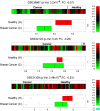A statistically inferred microRNA network identifies breast cancer target miR-940 as an actin cytoskeleton regulator
- PMID: 25673565
- PMCID: PMC5389139
- DOI: 10.1038/srep08336
A statistically inferred microRNA network identifies breast cancer target miR-940 as an actin cytoskeleton regulator
Abstract
MiRNAs are key regulators of gene expression. By binding to many genes, they create a complex network of gene co-regulation. Here, using a network-based approach, we identified miRNA hub groups by their close connections and common targets. In one cluster containing three miRNAs, miR-612, miR-661 and miR-940, the annotated functions of the co-regulated genes suggested a role in small GTPase signalling. Although the three members of this cluster targeted the same subset of predicted genes, we showed that their overexpression impacted cell fates differently. miR-661 demonstrated enhanced phosphorylation of myosin II and an increase in cell invasion, indicating a possible oncogenic miRNA. On the contrary, miR-612 and miR-940 inhibit phosphorylation of myosin II and cell invasion. Finally, expression profiling in human breast tissues showed that miR-940 was consistently downregulated in breast cancer tissues.
Conflict of interest statement
The authors declare no competing financial interests.
Figures





References
-
- Kloosterman W. P. & Plasterk R. H. A. The Diverse Functions of MicroRNAs in Animal Development and Disease. Dev. Cell 11, 441–450 (2006). - PubMed
-
- Alvarez-Garcia I. & Miska E. A. MicroRNA functions in animal development and human disease. Development 132, 4653–4662 (2005). - PubMed
-
- Lee R. C., Feinbaum R. L. & Ambros V. The C. elegans heterochronic gene lin-4 encodes small RNAs with antisense complementarity to lin-14. Cell 75, 843–854 (1993). - PubMed
Publication types
MeSH terms
Substances
LinkOut - more resources
Full Text Sources
Other Literature Sources
Medical

